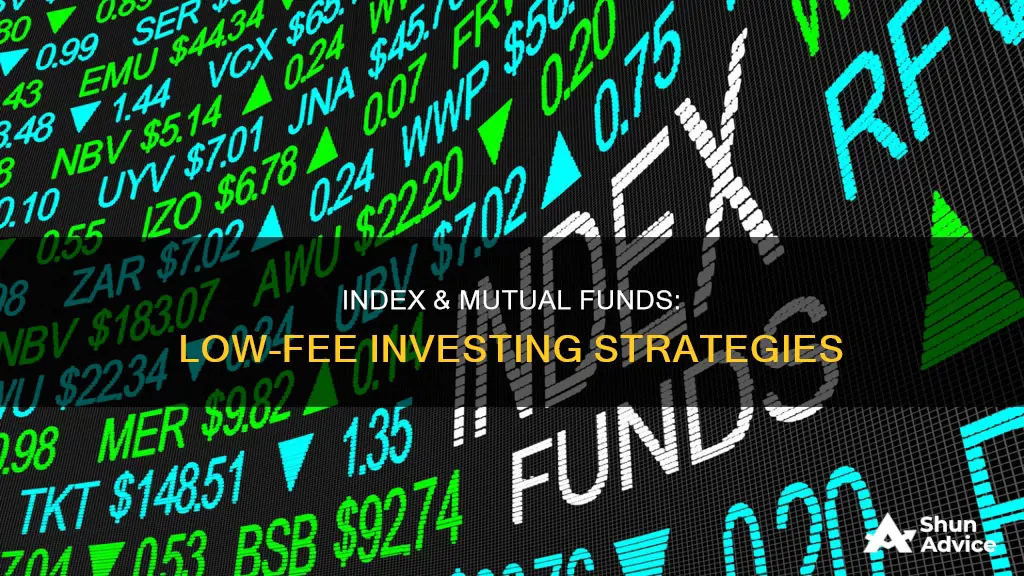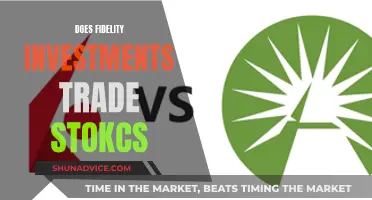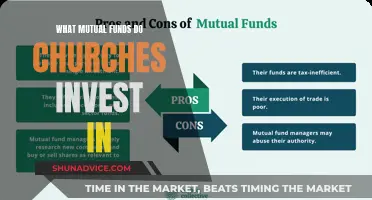
Index funds and mutual funds are a great way to invest in the stock market. They can reduce your risks compared to investing in individual stocks, and they're a good choice if you want to minimise the time and money you spend investing.
Index funds are passive investments that track a specific collection of assets called an index. The index can include stocks, bonds and other assets, such as commodities like gold. The most well-known index is the Standard & Poor's 500 (S&P 500), which includes about 500 of the largest publicly traded American companies.
Mutual funds are actively managed and tend to be more expensive than ETFs, but they can be a good option for investors who want to diversify their portfolio and have more control over their investments.
- Check the fund's performance over the past one to ten years to get a sense of what you could earn in an average year.
- Look up the fund's expense ratio to determine what percentage of your investment you'll pay as a fee. Lower expense ratios are better for investors.
- Avoid sales load, which is a commission to the salesperson that comes directly out of your pocket. Many fund management companies offer no-load funds.
- Consider the fund's investment minimum, which is the amount of money you need to start investing. ETFs tend to have lower investment minimums than mutual funds.
- Diversify your portfolio by investing in a range of different funds, including stock funds and bond funds.
| Characteristics | Values |
|---|---|
| Type of fund | Mutual or exchange-traded fund (ETF) |
| Investment strategy | Passive |
| Investment aim | To track a specific market index |
| Investment management | Not actively managed |
| Investment costs | Lower fees and expenses than actively managed funds |
| Investment performance | Often outperform actively managed funds |
| Investment risk | Less risky due to diversification |
What You'll Learn

Understand the difference between index funds and actively managed funds
Index funds and actively managed funds are two types of investment funds with different approaches to portfolio management and investment objectives. Here are the key differences between the two:
Management Style:
- Index Funds: Index funds are passively managed, meaning they aim to mirror the performance of a specific market index, such as the S&P 500. The fund will buy and hold all or a representative sample of the stocks or bonds in the index it tracks. The goal is to match the index's performance as closely as possible, and the fund's holdings are adjusted only when the index itself changes.
- Actively Managed Funds: Actively managed funds, on the other hand, employ professional money managers who actively select investments with the goal of outperforming the market. These funds try to beat market returns by hand-picking stocks or bonds based on the manager's research and expertise.
Investment Objective:
- Index Funds: The primary objective of index funds is to replicate the performance of the underlying index as closely as possible. They seek market-average returns and aim for long-term wealth accumulation by minimising fees and turnover.
- Actively Managed Funds: Actively managed funds aim to outperform the market and generate higher returns than the benchmark index. They seek to identify mispriced assets and capitalise on short-term market opportunities.
Cost:
- Index Funds: Index funds are known for their low investment costs compared to actively managed funds. They have lower expense ratios because they require less active management and fewer analysts and stock pickers. Index funds are often cheaper to run due to their passive nature, resulting in lower fees for investors.
- Actively Managed Funds: Actively managed funds tend to have higher fees as they cover the salaries, bonuses, and benefits of the fund managers and other employees. These costs are passed on to the investors through higher expense ratios and sales loads. The higher fees can impact the overall returns of the fund.
Performance and Risk:
- Index Funds: The performance of index funds is relatively predictable as it closely follows the underlying index. The risk is directly aligned with the specific stock or bond market the fund tracks. Index funds tend to have lower volatility compared to actively managed funds.
- Actively Managed Funds: The performance of actively managed funds can be less predictable as it depends on the expertise and decisions of the fund manager. There is a risk that the fund manager may underperform the benchmark index. Actively managed funds may have higher returns in the short term but tend to be more volatile.
In summary, the choice between index funds and actively managed funds depends on your investment goals, risk tolerance, and cost considerations. Index funds offer a passive, low-cost approach to investing, seeking to mirror market performance. Actively managed funds, on the other hand, aim to beat the market through active stock selection but come with higher fees and potentially higher risk.
Mutual Fund Investments: Where to Show Them in Your ITR
You may want to see also

Learn about the types of index funds available
Index funds are a great investment for building wealth over time, especially for beginners. They are a group of stocks that mirror the performance of an existing stock market index, such as the Standard & Poor's 500 index.
There are several types of index funds available, each with its own unique strategy and focus. Here are some of the most common types:
- Broad market index funds aim to capture the majority of an investable market, which could include stocks, bonds, or other assets. These funds provide low-cost exposure to an entire asset class, country, or region. Examples include the Vanguard Total Stock Market ETF and the Schwab U.S. Broad Market ETF.
- Market cap index funds invest based on specific market capitalization ranges. Large-cap funds, such as funds that track the S&P 500, generally hold companies with market caps above $10 billion, while small-cap funds tend to hold companies with market caps below $2 billion. Examples include the Fidelity 500 Index Fund and the Vanguard Mid-Cap ETF.
- Equal weight index funds allocate an equal percentage of the fund's assets to each holding, rather than weighting them by market cap. This approach reduces the risk of any single company dominating the fund's performance. Examples include the Invesco S&P 500 Equal Weight ETF and the Direxion Nasdaq-100 Equal Weighted Index Shares.
- Fixed income/debt index funds focus on investing in bonds rather than stocks. These funds track bond indices and typically charge lower expense ratios compared to actively managed funds. Examples include the Vanguard Long-Term Bond ETF and the iShares 1-5 Year Investment Grade Corporate Bond ETF.
- Sector-based index funds are ideal if you have a specific view on a certain area of the economy. These funds allow you to express an investment opinion without the need to research individual securities. Examples include the Consumer Discretionary Select Sector SPDR Fund and the Vanguard Communication Services Index Fund.
- International index funds provide an easy way to gain exposure to geographic areas outside of your home country. These funds offer a diversified portfolio of companies from a specific country or region. Examples include the Vanguard FTSE Emerging Markets ETF and the iShares Core MSCI Total International Stock ETF.
- Socially responsible index funds have gained popularity in recent years as investors increasingly care about how their money is invested. These funds may include companies with a focus on environmental, social, and governance issues or exclude companies involved in activities such as the sale of firearms, alcohol, or tobacco. Examples include the Vanguard ESG U.S. Stock ETF and the iShares Global Clean Energy ETF.
When choosing an index fund, it's important to consider factors such as the fund's performance relative to its benchmark, the fund's operating expense ratio, and the fund's asset class and index methodology. Additionally, it's worth noting that some index funds are available as either exchange-traded funds (ETFs) or mutual funds, so you can choose the option that best suits your investment needs and platform.
Green Acre Capital Fund: A Guide to Investing
You may want to see also

Research and analyse index funds
Index funds are a type of investment vehicle that tracks a market index, such as the S&P 500, by holding the same stocks or bonds or a representative sample of them. Index funds are passively managed, meaning that investing decisions are based on trying to match the index. They are considered a long-term investment strategy and are popular due to their low fees and diversification benefits.
When researching and analysing index funds, there are several key factors to consider:
Company size and capitalisation
Index funds can track small, medium, or large companies, also known as small-, mid-, or large-cap indexes. This is an important factor to consider as it will impact the risk and return potential of the fund.
Geography
The geographic focus of the fund is another important consideration. Some funds focus on stocks that trade on foreign exchanges or a combination of international exchanges, offering exposure to specific regions or countries.
Business sector or industry
Different index funds focus on specific business sectors or industries, such as consumer goods, technology, or healthcare. Choosing a fund that aligns with your interests and goals is essential.
Asset type
Index funds can track various asset types, including stocks, bonds, commodities, and cash. Consider your risk tolerance and investment goals when deciding which asset type to invest in.
Market opportunities
Some index funds focus on emerging markets or other growing sectors. These funds can offer the potential for higher returns but may also carry more risk.
Fees and expenses
One of the critical advantages of index funds is their low fees. However, it is important to carefully review the expense ratio, management costs, and other fees associated with the fund. Even small differences in fees can impact your long-term investment returns.
Performance and tracking error
Index funds aim to mirror the performance of their underlying index. Review the fund's historical performance and compare it to the benchmark index to ensure it is meeting its goal. Also, look at the tracking error, which measures the variance between the fund's returns and the index's returns.
Fund size and liquidity
Larger funds often offer more liquidity and lower trading costs. However, it is important to compare the trading costs and liquidity of different funds to understand how easy it would be to liquidate your investment if needed.
Tax implications
Index funds have lower turnover than actively managed funds, resulting in fewer taxable events. However, it is essential to consider the tax implications of investing in index funds, especially if held in taxable accounts.
Provider and accessibility
Consider the provider of the index fund and the accessibility of the fund. Some funds may have high investment minimums, while others may be available through online brokerage platforms or investment apps.
Risk and volatility
All investments carry some risk, and index funds are no exception. Understand the risk and volatility associated with the specific index fund and how it aligns with your risk tolerance and investment goals.
Smart Money: Ultra-Short Term Funds Explained
You may want to see also

Decide which index fund to buy
Once you've chosen an index, you can generally find at least one index fund that tracks it. If you have more than one fund option for your chosen index, you'll want to ask some basic questions.
Firstly, which index fund most closely tracks the performance of the index? Secondly, out of the top index funds that meet your needs, which has the lowest costs? Thirdly, are there any limitations or restrictions on an index fund that prevent you from investing in it? For example, many mutual funds have minimum investment requirements.
You should also consider the fund's expenses as these could cost you tens of thousands of dollars over time. Compare the expenses of each fund you're considering. Sometimes a fund based on a similar index can charge 20 times as much as another.
If you're torn between a mutual fund and an exchange-traded fund (ETF), remember that mutual funds tend to be less tax-efficient than ETFs. At the end of the year, many mutual funds pay a taxable capital gains distribution, while ETFs do not. Mutual funds also often have a minimum investment amount, whereas ETFs do not.
If you're just getting started, an ETF can be the more practical choice. Many mutual funds require a minimum initial investment of $1,000 or more, whereas you can get started with an ETF with the cost of just one share. ETFs also tend to have a lower expense ratio.
Finally, if the fund provider has other index funds you're interested in using, that might make it easier to keep all your investments in one place.
A Guide to Investing in Sustainable Funds
You may want to see also

Purchase your index fund
Once you've decided on the index fund you want to invest in, you'll need to choose an investment platform. There are many online brokerages and investment platforms to choose from, so it's worth shopping around to find one that suits your needs. Some platforms may offer more robust customer support, research tools, and analytical tools than others, so consider what's important to you before making your decision.
After selecting a platform, you'll need to open and fund your account. This usually involves providing personal information, creating login credentials, and completing a questionnaire about your investment goals and risk tolerance. You can then deposit funds into your account, typically via a bank transfer.
With your account set up and funded, you can start researching different index funds to understand their performance history, management fees, and the indexes they track. Consider diversifying your portfolio by investing in several index funds to minimise risk and maximise returns.
Most platforms allow you to purchase shares in your chosen fund directly through their website or app with just a few clicks. Remember to monitor your portfolio periodically to ensure it remains aligned with your financial goals.
Where to buy index funds
You can purchase an index fund directly from a mutual fund company or a brokerage. The same goes for exchange-traded funds (ETFs), which are like mini mutual funds that trade like stocks throughout the day. When choosing where to buy your index fund, consider the following:
- Fund selection: Do you want to purchase index funds from various fund families? While the big mutual fund companies carry some of their competitors' funds, the selection may be more limited than what's available from a discount broker.
- Convenience: Find a single provider who can accommodate all your needs. For example, if you're only investing in mutual funds (or a mix of funds and stocks), a mutual fund company may be able to serve as your investment hub.
- Trading costs: If the commission or transaction fee isn't waived, consider how much a broker or fund company charges to buy or sell the index fund. Mutual fund commissions are typically higher than stock trading commissions, so keep this in mind when deciding where to purchase your index fund.
How to buy index funds
To purchase shares of an index fund, you'll need to open an investment account. This could be a brokerage account, an individual retirement account (IRA), or a Roth IRA. You can then buy the fund within this account.
When purchasing the fund, you may be able to select a fixed dollar amount to spend or choose a number of shares. The share price of the index fund and your budget will likely determine how much you're willing to invest. For example, if you have $1,000 to invest and the fund you're interested in is selling for $100 per share, you could purchase 10 shares.
Final thoughts
Index funds have become a popular investment choice due to their ease of use, diversity, and returns that often beat actively managed accounts. Remember, passive management doesn't mean you should completely ignore your index fund. Keep an eye on its performance and ensure it's mirroring the underlying index it's meant to track.
Real Estate Fund Investment: A Beginner's Guide to Success
You may want to see also
Frequently asked questions
An index fund is a type of mutual or exchange-traded fund (ETF) that tracks the performance of a market index, such as the S&P 500, by holding the same stocks or bonds or a representative sample of them. Index funds are defined as investments that mirror the performance of benchmarks like the S&P 500 by mimicking their makeup.
The two most important things to know about investing in low-cost index funds are the index's long-term returns and the cost to own the index fund. That is, you’ll want to earn the potentially largest return while paying as little as possible to the fund company to achieve that return.
Some of the most popular stock indexes include the S&P 500, the Dow Jones Industrial Average, the Nasdaq Composite, the Russell 2000, and the Russell 3000.
Index funds are popular with investors because they promise ownership of a wide variety of stocks, greater diversification, lower risk, and lower costs.







